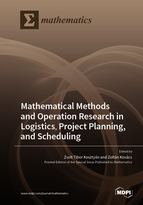Mathematical Methods and Operation Research in Logistics, Project Planning, and Scheduling
A special issue of Mathematics (ISSN 2227-7390). This special issue belongs to the section "Mathematics and Computer Science".
Deadline for manuscript submissions: closed (30 November 2022) | Viewed by 26262
Special Issue Editors
Interests: operational research; project management; quantitative methods
Special Issues, Collections and Topics in MDPI journals
Interests: operational research; supply chain; logistics; simulations
Special Issues, Collections and Topics in MDPI journals
Special Issue Information
Dear Colleagues,
In the last decade, the Industrial Revolution 4.0 brought flexible supply chains and flexible design projects to the fore. Nevertheless, the recent pandemic situation, the accompanying economic problems, and the resulting supply problems have further increased the role of logistics and supply chains. Therefore, planning and scheduling procedures that can respond flexibly to changed circumstances have become more valuable both in logistics and projects.
There are already several competing criteria of project and logistic process planning and scheduling that need to be reconciled. At the same time, the epidemic situation has shown that even more emphasis needs to be placed on taking potential risks into account. Flexibility and resilience are emphasized in all decision-making processes, including the scheduling of logistic processes, activities, and projects.
The aim of this Special Issue is to gather novel, original publications that offer new methods and approaches in the field of planning and scheduling in logistics and project planning that are able to respond to the challenges of the changing environment.
Prof. Dr. Zsolt Tibor Kosztyán
Prof. Dr. Zoltán Kovács
Guest Editors
Manuscript Submission Information
Manuscripts should be submitted online at www.mdpi.com by registering and logging in to this website. Once you are registered, click here to go to the submission form. Manuscripts can be submitted until the deadline. All submissions that pass pre-check are peer-reviewed. Accepted papers will be published continuously in the journal (as soon as accepted) and will be listed together on the special issue website. Research articles, review articles as well as short communications are invited. For planned papers, a title and short abstract (about 100 words) can be sent to the Editorial Office for announcement on this website.
Submitted manuscripts should not have been published previously, nor be under consideration for publication elsewhere (except conference proceedings papers). All manuscripts are thoroughly refereed through a single-blind peer-review process. A guide for authors and other relevant information for submission of manuscripts is available on the Instructions for Authors page. Mathematics is an international peer-reviewed open access semimonthly journal published by MDPI.
Please visit the Instructions for Authors page before submitting a manuscript. The Article Processing Charge (APC) for publication in this open access journal is 2600 CHF (Swiss Francs). Submitted papers should be well formatted and use good English. Authors may use MDPI's English editing service prior to publication or during author revisions.
Keywords
- resilience and flexibility in planning and scheduling
- multi-objective decision making
- risk evaluation and analysis
- control and coordination in supply chains and networks
- mathematical methods
- operations research







